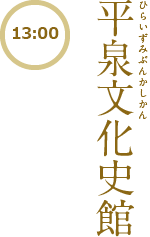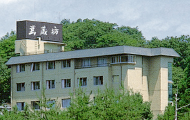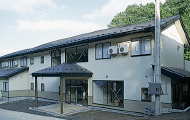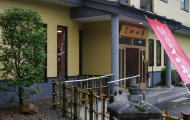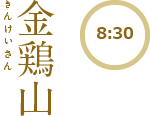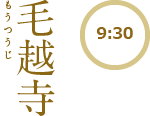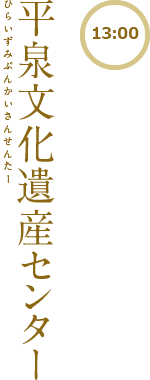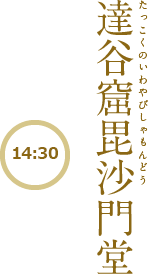Home ≫ Model Courses ≫ The Hiraizumi of Michinoku

No matter how many times you visit, the ancient city of Hiraizumi always shows you something new and magical at that time or in that instant.You can sense the Pure Land World built by the 3 generations of the Fujiwara clan amidst the eternity of time here.So, let’s look at the two-day trip in the Hiraizumi of Michinoku
Kataribe Taxi
The taxi drivers guide you around the historic sites and tourist places around Hiraizumi.If you have preferences, they will suggest routes that fit the season or your intentions for the trip. (Prices are based on how long you book these private tourist taxis for.)

Chuson-ji TempleYou have plenty of time so why not try copying a sutra by hand. You’ll feel like your heart is being cleansed as you carefully copy character by character. After finishing writing, it will presented to the god of the temple. Every year on the 2nd Sunday in June, the Hokekyo Ichinichi Tonshakyo is held with over 100 participants from all over Japan gathering to copy the Hokekyo Sutra Part 1 with its 68,000 characters in one day all at once.
A reservation is necessary for sutra copying.How to do sutra copying is explained here so there’s no problem for people trying it for the first time.
Further information here
0.4km
Have Green Tea and a Rest
Have Green Tea and a Rest
0.1km

Hakusan ShrineThis shrine which is located north of the Konjiki-do (Golden Hall) actually has a longer history than Chuson-ji Temple. It’s said to have been enshrined in this location by the high monk Ennin who founded Chuson-ji Temple. The Noh stage just next to the haiden (worship hall) is designated as an important cultural asset and performances are held on it during the Fujiwara Festival and for takigino (Noh theatre performed at night by a fire).
1km
Eating in the Tsukimi-zaka Slope Area
Eating in the Tsukimi-zaka Slope Area
Summary of places to eat here
0.1km

Hiraizumi Culture and History MuseumThis museum showcases the different faces of Hiraizumi in the later period of the Heian era when the Oshu Fujiwara clan governed this area and in the Edo era when the Date clan governed this area. The miniature models of Muryoko-in Temple, Motsu-ji Temple and the two-storey main hall were created based on the academic research of Gaijiro Fujishima, an emeritus professor of Tokyo University, that was his lifework and the models are so realistic that you can’t help but gazing and gazing at them.
0.7km
0.5km

Muryoko-in Temple RemainsMuryoko-in Temple was built in the image of the Houdo (Phoenix Hall) at Byodo-in Temple in Uji, Kyoto by Hidehira, the 3rd lord of Fujiwara. There’s no building here these days, however you can tell they were aiming to surpass the Houdo (Phoenix Hall) of Byodo-in Temple. The center of the building joined with Mt. Kinkei to the west and the setting sun went down along the line of the mountain ridge (and the temple building). It’s thought that it was designed this way to make it in the image of the Pure Land.
Further information here
0.5km
Stay in Hiraizumi
Have a relaxing stay in the world heritage town of Hiraizumi where time flows eternally.
Summary of places to stay here
 Early Morning Zen Meditation Group (Socho Zasenkai)
Early Morning Zen Meditation Group (Socho Zasenkai)
At Motsu-ji Temple during the summer vacationon designated days, early morning Zen meditation classes are held.In the light of morning,go into a Zen-like state in the hondo.(Reservations necessary)
 Early Morning Walks
Early Morning Walks
Mornings in Hiraizumi are a tranquil world.Why not take a walk to these recommended viewing spots?
・Tsukimi-zaka Slope(the morning haze)
・Higashimono Midai
・Kanjizaio-in Temple Remains

Mt. KinkeiThis mountain is located halfway between Chuson-ji Temple and Motsu-ji Temple. It’s the foundation for the creation of the town of Hiraizumi and one of the assets that comprises the world heritage area here. The origin of the name comes from that fact a golden cockerel and hen were buried on the mountain top.
0.1km

The Grave of Yoshitsune’s Wife and DaughterYoshitsune, who incurred the displeasure of his elder brother Yoritomo, took a small group of men and his lawful wife Gozen Sato with him and relied on the protection of Hidehira. After Hidehira’s death, Yoshitsune was attacked by Yasuhira (Hidehira’s son) and Yoshitsune killed his own wife and 4 year old daughter and then took his own life. The grave of Gozen Sato and his daughter is at the foot of Mt. Kinkei and even now memorial services are properly observed.
1km

Motsu-ji TempleThe spacious grounds are an excellent place for taking a leisurely walk. The Jodo garden here, which has become a byword for Motsu-ji Temple, is important in a scholarly sense and you can enjoy the different scenes of the four seasons here. You can also discover the location of the scene where the actress Sayuri Yoshinaga appeared in a commercial here while leisurely strolling around Oizumi ga Ike Pond.Have your photo taken in the same pose as Sayuri Yoshinaga!
Further information here
2km

Hiraizumi Cultural Heritage CenterThis is a facility where through easy to understand panels, displays and explanations you can understand the appeal of the historical and cultural heritage of Hiraizumi including its assets registered as world heritage. There’s also a Fureai Hall and a research facility connected to the center and the center can be used for arts and cultural activities too. The audio guides here are in four different languages so customers from overseas can use them without any problem.
Further information here
6km

Takkoku no Iwaya Bishamon-do TempleTakkoku no Iwaya Bishimon-do was given this name as the God Bishamon was enshrined here when it was built by the commander-in-chief Sakanoue no Tamuramaro to commemorate suppressing the Ezo. Takkoku no Iwaya is in the grounds of and under the administration of Takkoku Seiko-ji Temple. Bishamon-do was in sacred grounds separate from Seiko-ji Temple. Minamoto no Yoritomo visited this temple on his return trip to Kamakura and this location is recognized as a power spot these days
To the west of Bishamon-do, there’s a magaibutsu (Buddha statue) engraved into a cliff of about 30m in height. It’s said to have been carved by Minamoto no Yoshiie firing arrows at the cliff from the back of his horse to commemorate the souls of people who died in battle.
Return to the summary of the recommended tourist route



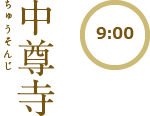
 Kanzantei
Kanzantei Sankozo
Sankozo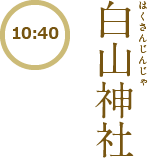
 Yoshiie
Yoshiie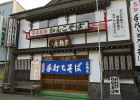 Senkyoan Soba Shop
Senkyoan Soba Shop